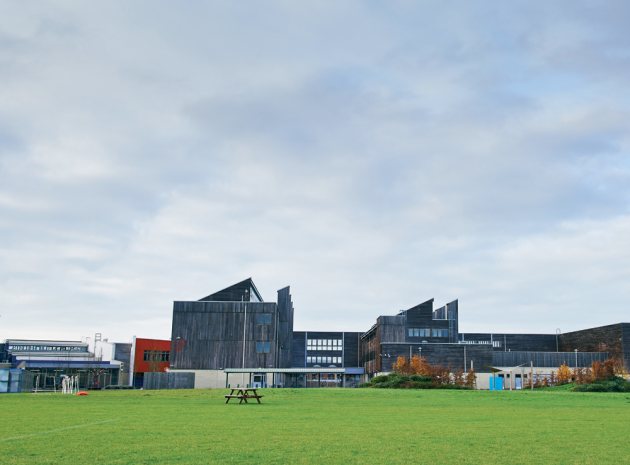“It’s variously known as ‘the sauna’, or ‘the prison’,” grins the first of a succession of charming, quietly confident sixth formers who have been persuaded by means of a largely chocolate-based bribe to devote a study period to showing me and my photographer around Oakgrove Academy, in Milton Keynes. I can see why the former sobriquet applies – even without the vast expanses of distinctive cedar cladding that enhance its exterior walls and boost its ecocredentials, the clean, simple lines of this £20m new-build school, and the way it effortlessly harmonises with the landscape, certainly recall something of a Scandinavian sense of pragmatic urban development.
The alternative nickname, however, is pure parody – as evidenced by the fact that it’s shared with us at all. Our guide knows that we are here with the intention of reporting on what we see; and, like everyone else we meet during our visit, is both proud of and deeply, genuinely affectionate towards her school. This is an establishment where the highest standards of behaviour and achievement are expected from everyone, at all times – but if the students are ‘prisoners’, then all young people should be lucky enough to experience such a supportive, encouraging, aspirational incarceration.
Time to grow
Oakgrove opened in September 2005; planned, designed and, crucially, funded to meet the rapidly evolving educational needs of a town with the fastest growing population base in Europe. The brief was clearly to establish a school that could, as far as would be reasonable, keep up with that growth – expansion was always a central strand of the vision, and continues to be so. From a starting point of two year groups (7 and 8) and 19 staff, head teacher Peter Barnes has seen his responsibilities extend over time to the management of 180 people in charge of educating 1,168 young people from 11-18. From 2015, an extra 30 students will be accepted to each year group and meanwhile, a primary setting is planned, plus nursery, enabling Oakgrove ultimately to offer all-through provision.
There’s no denying that the expansion is desperately needed; another housing estate is already being built within sight of the campus, and currently there are twice the number of applications for every available place at Oakgrove – although the school’s recent Ofsted grading, of ‘outstanding’ across the board, probably has as large a part to play in this as the shifting demographic of the catchment area.
“It’s true that success enhances reputation,” agrees Barnes. “We began with a very clear vision of what we wanted to offer – one that was developed in consultation with a whole range of stakeholders. Right at the heart of it was the highest quality of teaching and learning, and of course, starting from scratch gave us the luxury of being able to plan processes and systems we knew would work, and embed them right from the start. Most of what we decided back then is still in place, and our results, both in terms of academic achievement and student happiness, are evidence that we got it right. Reputations can fall quite quickly, though, which is why you mustn’t get distracted and take your eye off the ball. We keep the essence in place, and we’re not complacent.”
Individual assets
Some observers might point out that, given Oakgrove’s initial circumstances – generous funding, expansive vision, supportive governance, a relatively prosperous catchment area and above all, an intake demographic that reflects national averages across all levels of ability with almost uncanny precision – anything less than outstanding achievement should surely have been next to unthinkable. However, history has demonstrated time and time again that there are no guarantees when it comes to education – and Barnes and his team have no intention of relying on statistical likelihood to ensure great outcomes. Oakgrove students are nurtured and inspired as individuals, regardless of their background or starting level, and the key figures to look at if you want real proof of the added value provided by the teaching and learning here, are those that show progress made from the start of KS3, to the start of KS4, which is above average for all abilities, including those at both extremes of the scale – and often dramatically so.
“Standards are very high,” responds Emma Pilgrim, assistant head teacher, and responsible for developing teaching and learning across the school, when I ask her why she thinks this is the case. “I think it comes from being a brand new school, with clear expectations for both staff and students that have been explicit right from the outset. We’ve always focused on the importance of ensuring that pupils know where they are, and exactly what they need to do to improve, and that teachers are differentiating for all abilities and marking effectively to help learners make progress.”
“Marking is something we’ve been working on recently in our twilight sessions,” adds Charlotte Hawker, an advanced skills teacher who is part of Pilgrim’s teaching and learning team. “We hold them once a month, on a Monday evening, and all teachers attend – they’re a chance for us to share ideas and experiences, and come up with new approaches, which we then trial on a small scale before reviewing them at the next session and then, if they’ve been successful, rolling them out to the whole school.”
Tried and tested
This collaborative and step-by-step approach to continuous improvement bodes well for Oakgrove’s future. No one is resting on his or her laurels – but thanks to an extremely solid foundation of methods and systems, there is no need for anyone to come up with dramatic reframings of how things are done currently, which leaves everyone free to suggest and test options for making what is already outstanding, even better. In many ways, it’s a (small ‘c’) conservative approach to education – but in the context of a modern environment, and, more importantly, driven by 21st century, fully inclusive expectations and ambitions. “Our core values are quite traditional,”
explains Emma Pilgrim. “They’re very recognisable; students here know where they stand, and so do their parents. Our young people want to succeed; they want to be learning ambassadors, and represent the school. They wear their badges with pride. And our teachers are incredibly motivated and supported – it’s a positive atmosphere, inspiring all of us to learn together, all the time.”
“On the whole, we like to manage things in-house, and we like to manage them together,” concludes Peter Barnes. And it’s a fair prediction that, as long as things continue along their current trajectory of steady, upwards progress from an above-average base, no one – from Ofsted to prospective parents and carers – will question the wisdom of allowing Barnes and his team to carry on doing precisely that.











Manners at oakgrove are exemplary; students are polite, respectful and kind – not only to the adults they encounter, but also to each other. classrooms, corridors and outside areas feel welcoming,…